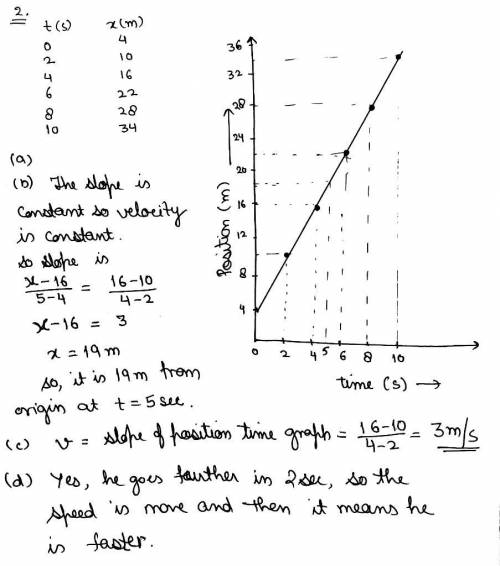
Physics, 28.09.2021 23:00, AgentPangolin
in a second trial, the timer started his watch a bit late. Using the data from the second trial: a. plot the position vs. time graph for the skater. b. How far from the origin was she at t=5 second? How do you know? c. was her speed constant? If so, what was it? d. In the first trial, the skater was further along at 2 seconds than she was in the second trail. Does this mean that he was going faster? Explain your answer.

Answers: 2
Other questions on the subject: Physics

Physics, 22.06.2019 10:30, tay8556
The uniform slender bar rests on a smooth horizon- tal surface when a force f is applied normal to the bar at point a. point a is observed to have an initial acceleration aa of 20 m/s2, and the bar has a corre- sponding angular acceleration of 18 rad /s2. deter- mine the distance b.
Answers: 1

Physics, 22.06.2019 16:20, adiafloresp2dkbx
Specific heat refers to the amount of heat required to change 1 gram of a substance by degree(s) celsius
Answers: 1

Physics, 22.06.2019 20:20, breannaasmith1122
Consider a file currently consisting of 200 blocks. assume that the file control block (and the index block in the case of indexed allocation) is already in memory. calculate how many disk i/o operations are required for contiguous, linked, and indexed (single-level) allocation strategies, for each of the conditions listed below. in the contiguous-allocation case, assume that there is not room to grow at the beginning but there is room to grow at the end. also assume that the block information to be added is stored in memory.
Answers: 3

Physics, 22.06.2019 21:20, payshencec21
People with normal vision cannot focus their eyes underwater if they aren't wearing a face mask or goggles and there is water in contact with their eyes. in a simplified model of the human eye, the aqueous and vitreous humors and the lens all have a refractive index of 1.40, and all the refraction occurs at the cornea, whose vertex is 2.60 cm from the retina. with the simplified model of the eye, what corrective lens (specified by focal length as measured in air) would be needed to enable a person underwater to focus an infinitely distant object? (be careful-the focal length of a lens underwater is not the same as in air! assume that the corrective lens has a refractive index of 1.62 and that the lens is used in eyeglasses, not goggles, so there is water on both sides of the lens. assume that the eyeglasses are 2.05cm in front of the eye.)
Answers: 3
Do you know the correct answer?
in a second trial, the timer started his watch a bit late. Using the data from the second trial: a....
Questions in other subjects:


Social Studies, 28.06.2019 10:00


Mathematics, 28.06.2019 10:00

Biology, 28.06.2019 10:00

History, 28.06.2019 10:00



Mathematics, 28.06.2019 10:00

Biology, 28.06.2019 10:00







